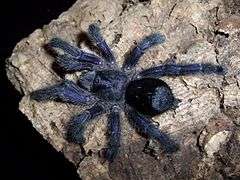Avicularia purpurea
| Avicularia purpurea | |
|---|---|
| | |
| Scientific classification | |
| Kingdom: | Animalia |
| Phylum: | Arthropoda |
| Subphylum: | Chelicerata |
| Class: | Arachnida |
| Order: | Araneae |
| Infraorder: | Mygalomorphae |
| Family: | Theraphosidae |
| Genus: | Avicularia |
| Species: | A. purpurea |
| Binomial name | |
| Avicularia purpurea Kirk, 1990[1] | |
Avicularia purpurea, also called purple tree tarantula, Ecuadorian purple tarantula[2] or Ecuador purple pinktoe,[3] is a species of spider belonging to the family Theraphosidae (tarantulas).[1]
Distribution
These spiders are mainly present in Ecuador in the Amazon Region.[2]
Habitat
This species can be found in very different habitats, but frequently it is present in agricultural areas, especially in the field of grazing cattle. Sometimes it can be found in holes of walls of buildings or in the spaces below the roofs.[2][4][3]
Description

Avicularia purpurea can reach a length of about 5 centimetres (2.0 in) and a weight of about 400 grams, therefore it is among the smaller members of the genus Avicularia.[5]
In daylight this spider discloses a quite intense purple-blue iridescence on the dorsal surface of the cephalothorax and on legs, palps and chelicerae. The long setae covering the legs and palps are dark red-brown. The tarsal and metatarsal scopulae are very dark brown. The tarsal tufts are pale cream-pink in colour. The abdomen is velvet-black and covered with stinging hairs.[2][4]
Behavior
Avicularia purpurea is primarily an arboreal spider. This climbing species builds its nests primarily in hollows in the trees, sometimes in the vicinity of epiphytic plants. These spiders eat mostly crickets, cockroaches, meal worms, waxworms and darkling beetles, but they also can catch small rodents. During mating the females become very aggressive towards the males. A few months after mating the female lays up to 120 eggs in a cocoon.[4] Six to eight weeks later between 50 and 120 nymphs hatch.[2][3][5][6]
References
- 1 2 "Taxon details Avicularia purpurea Kirk, 1990". World Spider Catalog. Natural History Museum Bern. Retrieved 2016-03-25.
- 1 2 3 4 5 The tarantula's burrow
- 1 2 3 TarantulasUS
- 1 2 3 Kirk, P.J. (1990). "Avicularia purpurea, a new species of theraphosid spider from Ecuador". British Tarantula Society Journal. 6 (1): 15–19.
- 1 2 Peters, Heinz-Josef (2003). Amerika's Vogelspinnen. Tarantulas of the World (in German). Wegberg: H.-J. Peters. pp. 93–94. ISBN 978-3-933443-06-9.
- ↑ Tinter, Andreas (2001). Vogelspinnen : Gifte, Lebensweise, Verhalten (in German). Hamburg: Nikol. ISBN 978-3-933203-49-6.